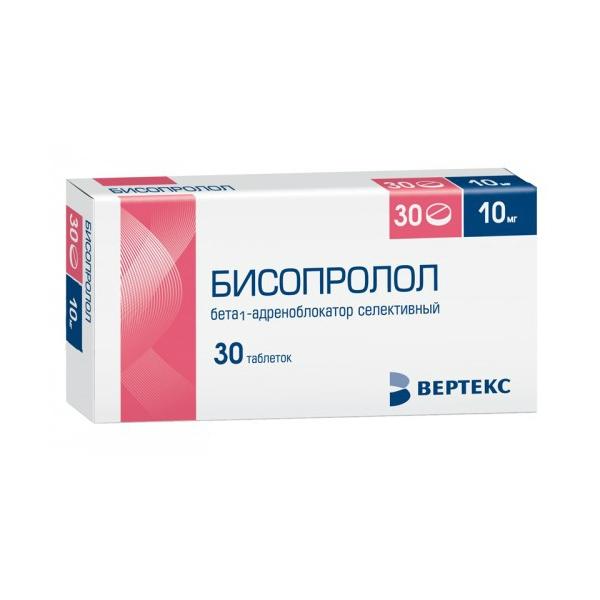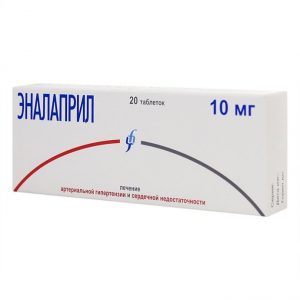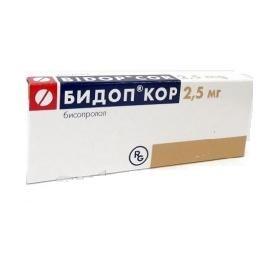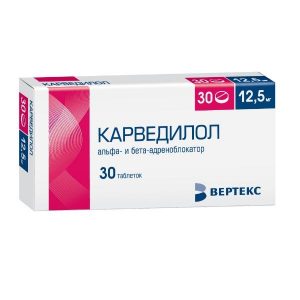Description
Latin name
Bisoprolol
Release form
Coated tablets.
Packing
30 pcs
Pharmacological action of
Bisoprolol is a selective beta1-blocker without internal sympathomimetic activity, does not have membrane-stabilizing activity.
Bisoprolol reduces plasma renin activity, reduces myocardial oxygen demand, reduces heart rate (at rest and during exercise) and cardiac output, while stroke volume does not significantly decrease. Inhibits AV conduction.
It has antianginal and hypotensive effects. In high doses (200 mg or more), it can cause blockade and 2-adrenoreceptors mainly in the bronchi and in the smooth muscles of blood vessels.
Indications
Arterial hypertension, prevention of angina attacks.
Contraindications
Chronic heart failure II B – III stage, cardiogenic shock, AV block II and III degree, CVD, sinoatrial block, bradycardia, arterial hypotension (systolic pressure less than 90 mm Hg) tendency to bronchospasm ( and other diseases with bronchial obstructive syndrome), severe peripheral circulatory disorders, concomitant use of MAO inhibitors (with the exception of MAO inhibitors of type B), increased sensitivity to bisoprolol and other beta-blockers, pregnancy and lactation.
Use during pregnancy and lactation
Use during pregnancy and lactation is possible if the benefit to the mother outweighs the risk of side effects in the fetus and the baby.
Composition
1 tablet contains bisoprolol (in the form of a fumarate) 10 mg.
Dosage and administration
Dosing regimen is individual.
For oral administration, the daily dose of bisoprolol is 2.5-10 mg, the frequency of administration is 1 time / day.
The maximum daily dose is 10 mg.
Side effects of
From the side of the central nervous system and peripheral nervous system: weakness, fatigue, dizziness, headache, sleep disorders, mental disorders (depression, rarely hallucinations), a feeling of cold and paresthesia in the limbs.
From the cardiovascular system: orthostatic hypotension, bradycardia, impaired AV conduction, the appearance of symptoms of heart failure, worsening intermittent claudication and the main clinical symptoms in Raynaud’s syndrome.
From the side of the organ of vision: decreased secretion of lacrimal fluid, conjunctivitis.
From the digestive system: diarrhea, constipation, nausea, abdominal pain.
From the musculoskeletal system: muscle weakness, muscle cramps.
the risk of severe systemic allergic reactions or anaphylaxis in patients receiving bisoprolol.
Iodine-containing X-ray contrast agents for I / O administration increase the risk of anaphylactic reactions.
Phenytoin with / in administration, medications for inhalation general anesthesia (hydrocarbon derivatives) increase the severity of cardio-depressive action and the likelihood of reducing blood pressure.
Changes the effectiveness of insulin and oral hypoglycemic drugs, masks the symptoms of developing hypoglycemia (tachycardia, increased blood pressure).
Reduces the clearance of lidocaine and xanthines (except for dipyllin) and increases their plasma concentrations, especially in patients with initially elevated theophylline clearance under the influence of smoking.
Hypotensive effect is weakened by NSAIDs (Na + retention and blockade of prostaglandin synthesis by the kidneys), ACS and estrogens (retention of Na + ions).
Cardiac glycosides, methyldopa, reserpine and guanfacin, slow calcium channel blockers (verapamil, diltiazem), amiodorone and other antiarrhythmic drugs increase the risk of developing or worsening bradycardia, AV blockade, cardiac arrest and cardiac arrest.
Nifedipine can significantly reduce blood pressure.
Diuretics, clonidine, sympatholytics, hydralazine and other antihypertensive drugs can lead to an excessive decrease in blood pressure.
Extends the action of non-depolarizing muscle relaxants and the anticoagulant effect of coumarins.
Tri- and tetracyclic antidepressants, antipsychotic drugs (neuroleptics), ethanol, sedatives and sleeping pills increase CNS depression.
Concomitant use with MAOI inhibitors is not recommended due to a significant increase in antihypertensive activity, with a break of at least 14 days between taking MAOIs and bisoprolol.
Non-hydrogenated ergot alkaloids increase the risk of peripheral circulation disorders.
Ergotamine increases the risk of peripheral circulation disorders, sulfasalazine increases plasma bisoprolol concentrations, rifampicin shortens the elimination half-life.
Overdose
Symptoms:
arrhythmia, ventricular extrasystole, severe bradycardia, AV blockade, severe BP, chronic heart failure, cyanosis of nails of the fingers or palms, bronchitis, difficulty.
Treatment:
gastric lavage and the appointment of adsorbents symptomatic therapy: with the development of AV blockade – in / in the introduction of 1-2 mg of atropine, epinephrine or staging of a temporary pacemaker for ventricular extrasystole – lidocaine (class IA drugs are not used) in reducing blood pressure – the patient should be in Trendelenburg if there are no signs of pulmonary edema – in / in plasma-replacement solutions, with inefficiency, with enepinephin, of maintaining chronotropic and inotropic action and elimination of pronounced decrease in blood pressure) in heart failure – cardiac glycosides, diuretics, glucagon in convulsions – in / in diazepam in bronchosphere Beta beta-blockers are inhaled.
Storage conditions
Store in a dry, dark place, out of the reach of children, at a temperature not exceeding 20 ° C.
The Expiration of
is 3 years.
Active
bisoprolol
Conditions of supply of pharmacies
prescription
dosage form
Dosage form
tablets
Vertex, Russia




